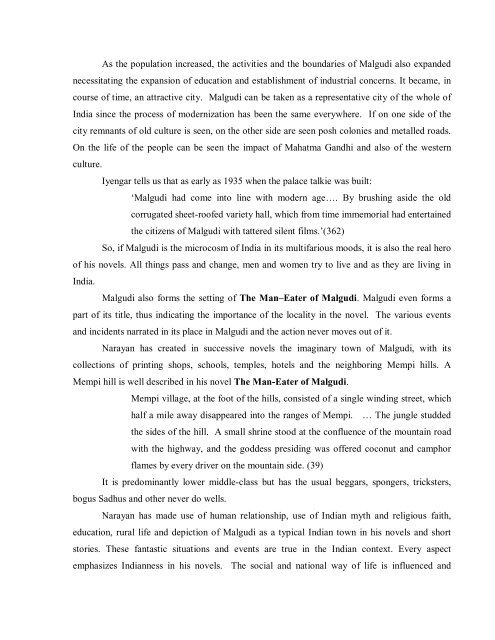A Multidisciplinary Research Journal - Devanga Arts College
A Multidisciplinary Research Journal - Devanga Arts College
A Multidisciplinary Research Journal - Devanga Arts College
Create successful ePaper yourself
Turn your PDF publications into a flip-book with our unique Google optimized e-Paper software.
As the population increased, the activities and the boundaries of Malgudi also expanded<br />
necessitating the expansion of education and establishment of industrial concerns. It became, in<br />
course of time, an attractive city. Malgudi can be taken as a representative city of the whole of<br />
India since the process of modernization has been the same everywhere. If on one side of the<br />
city remnants of old culture is seen, on the other side are seen posh colonies and metalled roads.<br />
On the life of the people can be seen the impact of Mahatma Gandhi and also of the western<br />
culture.<br />
Iyengar tells us that as early as 1935 when the palace talkie was built:<br />
‘Malgudi had come into line with modern age…. By brushing aside the old<br />
corrugated sheet-roofed variety hall, which from time immemorial had entertained<br />
the citizens of Malgudi with tattered silent films.’(362)<br />
So, if Malgudi is the microcosm of India in its multifarious moods, it is also the real hero<br />
of his novels. All things pass and change, men and women try to live and as they are living in<br />
India.<br />
Malgudi also forms the setting of The Man–Eater of Malgudi. Malgudi even forms a<br />
part of its title, thus indicating the importance of the locality in the novel. The various events<br />
and incidents narrated in its place in Malgudi and the action never moves out of it.<br />
Narayan has created in successive novels the imaginary town of Malgudi, with its<br />
collections of printing shops, schools, temples, hotels and the neighboring Mempi hills. A<br />
Mempi hill is well described in his novel The Man-Eater of Malgudi.<br />
Mempi village, at the foot of the hills, consisted of a single winding street, which<br />
half a mile away disappeared into the ranges of Mempi. … The jungle studded<br />
the sides of the hill. A small shrine stood at the confluence of the mountain road<br />
with the highway, and the goddess presiding was offered coconut and camphor<br />
flames by every driver on the mountain side. (39)<br />
It is predominantly lower middle-class but has the usual beggars, spongers, tricksters,<br />
bogus Sadhus and other never do wells.<br />
Narayan has made use of human relationship, use of Indian myth and religious faith,<br />
education, rural life and depiction of Malgudi as a typical Indian town in his novels and short<br />
stories. These fantastic situations and events are true in the Indian context. Every aspect<br />
emphasizes Indianness in his novels. The social and national way of life is influenced and



